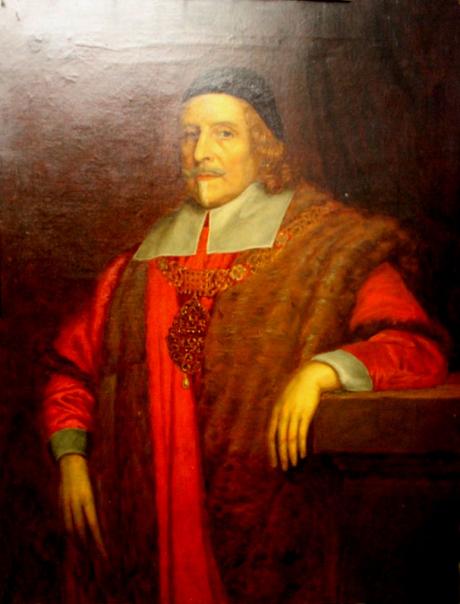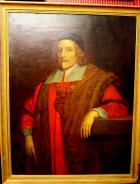Sir Thomas,Vyner [Viner], first baronet (1588–1665), goldsmith and banker, was born on 15 December 1588 at North Cerney in Gloucestershire, the son of Thomas Vyner, of a Warwickshire family, and his second wife, Anne. The younger Thomas was apprenticed in London, first to his half-sister's husband, Samuel Moore, of the Goldsmiths' Company, in 1601 and then to William Terry in 1604, taking his freedom in 1611. He first came to notice in 1624, when he obtained a reversion to the comptrollership of the mint—an appropriate investment for someone with his qualifications, though he never took up this office. In 1639 he sold £79 worth of plate to Edward Nicholas, the future royalist secretary of state, but his political sympathies are better indicated by his having advanced £100 for the parliamentarian army under the earl of Essex in October 1643. He was one of the contractors appointed to manage the sale of bishops' lands in 1646, and he was named to various London committees in the years following the civil war. His allegiances have been described as those of a political presbyterian in the years 1646–8. His attitude towards the Commonwealth seems equivocal: he became an alderman of the City of London in 1646 and remained one until 1660.
He served as high sheriff of the City of London in 1648–9 but certainly achieved greater prominence under the Cromwellian protectorate (1654–9) after the repeal of the engagement, the republican loyalty oath which expressed explicit approval of the abolition of monarchy and House of Lords and implicit support for the regicide. Even so, in December 1649 he was asked by the council of state to collect Spanish pieces of eight and to meet the admiralty committee if his other commitments permitted, and the next day he offered 7000 ryals at 4s 10d. each, pointing out that he could have asked for and received more than this. In 1652 he gave security for the settlement of his penal fine by the Catholic peer Lord Petre; but this was less a pointer to religious sympathy than a disguised way of obtaining the equivalent of a bond or mortgage. He was elected lord mayor of London in 1653–4 and was knighted by the protector at his inauguration in February 1654. In 1623 Vyner had acted as a co-treasurer or accountant for the money received from the Dutch East India Company as compensation for the Amboyna massacre, to be paid to the victims if they were still alive or, more likely, to their heirs and executors. He served in the same capacity for the funds raised to relieve various groups of persecuted European protestants, and he was involved in the transmission of captured Spanish bullion to the mint for coinage. He may also have acted as a banker for private individuals. His apprentices during the 1630s and 1640s included Edward Backwell, who was acting as a financier in his own right by the 1650s, and his own stepnephew Robert Vyner (1631–1688), who entered into an informal partnership with him in 1656.
Sir Thomas was married three times. His first wife was Anne, daughter of Richard Parsons of London, a merchant; they had five daughters, including Elizabeth who married Sir Henry Pickering, another Cromwellian knight who became a Restoration baronet, and Rebecca who married Sir Richard Piggott, a tax farmer and successor to his wife's stepbrother as an office-holder in chancery. Vyner's second wife was Honor Humble (d. 1656?), daughter of George Humble, of London, citizen and stationer; their two sons were George Vyner (d. 1673) and Thomas Vyner (d. c.1666). His third, who survived him, was Alice, widow of Alderman John Perryn; they had no children. There is little evidence of the activities of Thomas and Robert Vyner between the fall of Richard Cromwell and the Restoration. Along with all other Cromwellian titles, Sir Thomas's knighthood automatically lapsed with the return of monarchy in 1660, but within nine weeks he was reknighted by Charles II, though he did not recover his place as an alderman, which he lost to another returned royalist. In 1661 he petitioned unsuccessfully for the office of king's goldsmith. He was made a baronet on 18 June 1661 and despite his age took an active part in providing cash and credit for the government of the restored monarchy. On 11 May 1665 he died at his country house in Hackney (then a suburban village), Middlesex, and Samuel Pepys attended his funeral at St Mary Woolnoth in the City on 1 June. Sir Thomas certainly helped to lay the foundations for the achievements of later seventeenth-century goldsmith–bankers, notably his own apprentices Edward Backwell and Robert Vyner.
At his death Vyner had already established himself as a landed gentleman besides having had a house and an office in the City. He was perhaps fortunate in not having lived to see the effects of the plague, the great fire, and the naval disasters in 1667 at the end of the Dutch War. The arrangements at his death were a little unusual. The baronetcy passed to his son, Sir George Vyner, who was married to Abigail, daughter and coheir of Sir John Lawrence. George was also a member of the Goldsmiths' Company and, according to one authority, was acting as a banker around 1670; but he does not seem to have been very prominent as such, having by then established himself as a landed gentleman, as intended by his father. As required by the custom of the City, after payment of Sir Thomas's debts the residue was to be divided into three equal shares: one to his two sons, one to his wife, and the third, about £7000, to charities and other named legatees. All his real property in Middlesex and Essex was to go to Sir George for his lifetime, then to his heir apparent, Sir Thomas's grandson, and then to the grandson's heirs, in default of which to Sir Thomas's second son, Thomas, a minor office-holder in chancery, and his heirs. Sir George was required within two years to lay out a further £7000 on additional landed property; if he failed to do so, the bond for that amount entered into by his brother Thomas and his cousin Sir Robert (by an indenture of 1663) was to be forfeit to Thomas. If Sir Thomas's wife outlived him, she was to be paid £4330 by instalments, according to the marriage agreement made between them in 1658. This sum and a further £2500 which was to be paid by Sir George to his younger brother (in addition to an outright legacy of £2000 for Thomas) were both secured on part of the existing Essex property. To effect these complicated arrangements, the younger son was made sole executor, with two of Sir Thomas Vyner's sons-in-law and his stepnephew Sir Robert (here called ‘cousin’) as overseers of the will. The omission of the elder son is very striking. In the event Thomas, the executor, died only about a year and a half after his father, having made over his interest in the estate and the executorship to Sir Robert, who had already assumed sole control of the banking business at the Vine in Lombard Street (temporarily relocated after the great fire). Sir George died in 1673. When his son, Sir Thomas, third baronet, died under age and without heirs ten years later, the baronetage became extinct.
G. E. Aylmer DNB


